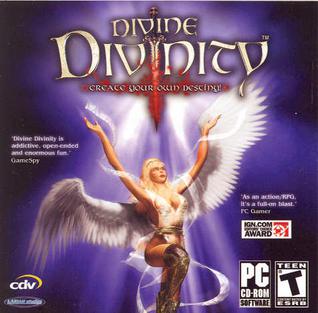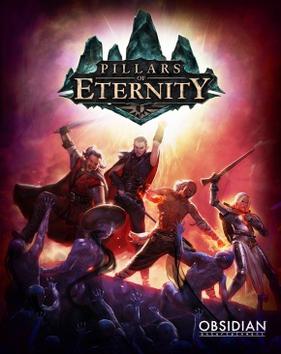
Baldur's Gate is a series of role-playing video games set in the Forgotten Realms Dungeons & Dragons campaign setting. The game has spawned two series, known as the Bhaalspawn Saga and the Dark Alliance, both taking place mostly within the Western Heartlands, but the Bhaalspawn Saga extends to Amn and Tethyr. The Dark Alliance series was released for consoles and was critically and commercially successful. The Bhaalspawn Saga was critically acclaimed for using pausable realtime gameplay, which is credited with revitalizing the computer role-playing game (CRPG) genre.

Wasteland is a role-playing video game developed by Interplay Productions and published by Electronic Arts in 1988. The first installment of the Wasteland series, it is set in a futuristic, post-apocalyptic America destroyed by a nuclear holocaust generations before. Developers originally made the game for the Apple II and it was ported to the Commodore 64 and MS-DOS. It was re-released for Microsoft Windows, OS X, and Linux in 2013 via Steam and GOG.com, and in 2014 via Desura. A remastered version titled Wasteland Remastered was released on February 25, 2020, in honor of the original game's 30th anniversary.

A role-playing video game, commonly referred to as a role-playing game (RPG) or computer role-playing game (CRPG), is a video game genre where the player controls the actions of a character immersed in some well-defined world, usually involving some form of character development by way of recording statistics. Many role-playing video games have origins in tabletop role-playing games and use much of the same terminology, settings and game mechanics. Other major similarities with pen-and-paper games include developed story-telling and narrative elements, player character development, complexity, as well as replay value and immersion. The electronic medium removes the necessity for a gamemaster and increases combat resolution speed. RPGs have evolved from simple text-based console-window games into visually rich 3D experiences.

Fallout 2: A Post Nuclear Role Playing Game is a 1998 role-playing video game developed by Black Isle Studios and published by Interplay Productions. It is a sequel to Fallout (1997), featuring similar graphics and game mechanics. The game's story takes place in 2241, 80 years after the events of Fallout and 164 years after the atomic war which reduced the vast majority of the world to a nuclear wasteland. The player assumes the role of The Chosen One, the grandchild of the first game's protagonist, and undertakes a quest to save their small village on the West Coast of the United States.
Obsidian Entertainment, Inc. is an American video game developer based in Irvine, California. It was founded in June 2003, shortly before the closure of Black Isle Studios, by ex-Black Isle employees Feargus Urquhart, Chris Avellone, Chris Parker, Darren Monahan, and Chris Jones.
Tactical role-playing games, also known as strategy role-playing games and in Japan as simulation RPGs, are a video game genre that combines core elements of role-playing video games with those of tactical strategy video games. The formats of tactical RPGs are much like traditional tabletop role-playing games and strategy games in appearance, pacing, and rule structure. Likewise, early tabletop role-playing games are descended from skirmish wargames such as Chainmail, which were primarily concerned with combat.

Divine Divinity is an action role-playing game developed by Larian Studios and published by cdv Software Entertainment for Microsoft Windows, which was released in September 2002. It has three sequels, Beyond Divinity, Divinity II, and Divinity: Original Sin II. It also has a prequel, Divinity: Original Sin, and a spin-off, Divinity: Dragon Commander. The game was released for Mac OS X on 15 November 2013.

Joshua Eric Sawyer, more commonly known and credited as Josh Sawyer, J.E. Sawyer, or JSawyer, is an American video game designer, known for his work on role-playing video games.
Icewind Dale is a role-playing video game series developed by Black Isle Studios. It is set in the Forgotten Realms Icewind Dale region, but takes place decades before the events described in R. A. Salvatore's books which made the area a part of Faerûn.

Fallout: A Post Nuclear Role Playing Game is a 1997 role-playing video game developed and published by Interplay Productions. In a mid-22nd century post-apocalyptic and retro-futuristic world, decades after a global nuclear war between the United States and China, Fallout's protagonist, the Vault Dweller, inhabits the underground nuclear shelter Vault 13. After customizing their character, the player must scour the surrounding wasteland for a computer chip that can fix the Vault's failed water supply system. They interact with other survivors, some of whom give them missions, and engage in turn-based combat where they battle until their action points are depleted.

Timothy Cain is an American video game developer best known as the creator, producer, lead programmer and one of the main designers of the 1997 computer game Fallout. In 2009, he was chosen by IGN as one of the top 100 game creators of all time.

Baldur's Gate: Dark Alliance is a 2001 action role-playing video game developed by Snowblind Studios and published by Interplay Entertainment subsidiary Black Rock Studios for the PlayStation 2 and the Xbox consoles, with High Voltage Software handling the GameCube port, and Magic Pockets developing the Game Boy Advance version. CD Projekt was developing a version for Microsoft Windows, but it was ultimately cancelled. In 2021, a 4K port of the game was released for the Xbox One, PlayStation 4, PlayStation 5, Xbox Series X/S, and Nintendo Switch. In December of the same year, a port for the PC was released.
In video games and other games, the passage of time must be handled in a way that players find fair and easy to understand. This is usually done in one of the two ways: real-time and turn-based.

Neverwinter Nights 2: Storm of Zehir is an expansion pack for the role-playing video game Neverwinter Nights 2, developed by Obsidian Entertainment and published by Atari Interactive. It was released in late 2008 in North America, Europe, and Australia. Like previous entries in the Neverwinter Nights series, Storm of Zehir is based on the paper and pencil fantasy role-playing game Dungeons & Dragons, and uses the game's 3.5 edition ruleset.
Western role-playing video games are role-playing video games developed in the Western world, including The Americas and Europe. They originated on mainframe university computer systems in the 1970s, were later popularized by titles such as Ultima and Wizardry in the early- to mid-1980s, and continue to be produced for modern home computer and video game console systems. The genre's "Golden Age" occurred in the mid- to late-1980s, and its popularity suffered a downturn in the mid-1990s as developers struggled to keep up with changing fashion, hardware evolution and increasing development costs. A later series of isometric role-playing games, published by Interplay Productions and Blizzard Entertainment, was developed over a longer time period and set new standards of production quality.

The Banner Saga is a tactical role-playing video game developed by Stoic Studio and published by Versus Evil. It was released for personal computers and mobile phones in 2014, for PlayStation 4 and Xbox One in 2016 and for Nintendo Switch in 2018.

Pillars of Eternity is a role-playing video game developed by Obsidian Entertainment and published by Paradox Interactive. It was released for Microsoft Windows, OS X, and Linux on March 26, 2015. The game is a spiritual successor to the Baldur's Gate and Icewind Dale series, along with Planescape: Torment. Obsidian started a crowdfunding campaign on Kickstarter for it in September 2012. The campaign raised over US$4 million, which was the highest funded video game at the time. The game uses the Unity engine.

Powered by the Apocalypse (PbtA) is a tabletop role playing game design framework developed by Meguey Baker and Vincent Baker for the 2010 game Apocalypse World and later adapted for hundreds of other RPGs.

Divinity: Original Sin II is a role-playing video game developed and published by Larian Studios. The sequel to 2014's Divinity: Original Sin and the fifth main entry in the Divinity series, the game was released for Microsoft Windows in September 2017. The player controls a "Godwoken", a Sourcerer who can harness and use a powerful magic known as Source, and becomes a pivotal figure in the fight against the Voidwoken, monstrous creatures who wreak havoc in the medieval fantasy world of Rivellon.

Pathfinder: Kingmaker is an isometric role-playing game developed by Russian studio Owlcat Games and published by Deep Silver, based on Paizo Publishing's Pathfinder franchise. Announced through a Kickstarter campaign in 2017, the game was released for Microsoft Windows, macOS, and Linux on 25 September 2018.















